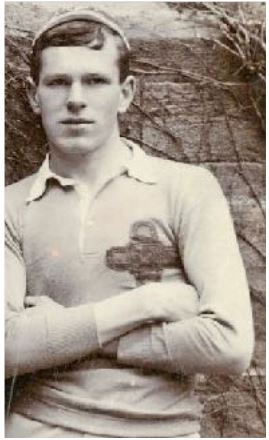Royal Army Medical Corps

George Reginald Ellis was born on 21 March 1885 at Bishop Auckland, Co Durham and his home was there, at a house called The Elms. He was the second son of Rosa Shafto (née Stratton) and George William Ellis.
Although a native of Bishop Auckland he was educated at Spondon House School, near Derby and at Sherbourne School from September 1899-1903, where he was a member of the rugby 1st XV in 1901. He then attended Durham University where he was awarded a Batchelor of Medicine. He was employed as a Doctor and Honorary Surgeon at the Lady Eden Hospital, Bishop Auckland. According to his newspaper obituary he was a ‘fine specimen of a man … tall and athletic but unassuming and popular …’ Upon the death of his father he had succeeded him at his practice as a doctor.
For some years he had been a member of the Territorial Forces and when war broke out he was commissioned into the Royal Army Medical Corps (RAMC) on 3 December 1914.
His National Archive file (WO374/22532) gives details of his service which was with 86th (2nd Northumbrian) Field Ambulance, RAMC, part of 28 Division. He served in France/Belgium from 19 January 1915 until at the latest 22 November 1915, when the Division arrived in Egypt. On 4 January 1916, he followed the Division to Salonika on the SS Nessian. On 19 May 1916 he was admitted to 28 Divisional Hospital with enteritis and on the 31st of that month was evacuated to Malta on the HS Oxfordshire. On the following day he was admitted to hospital with dysentery and on 19 June 1916 invalided to England, again aboard the HS Oxfordshire. He spent time up to January 1917 in 3rd Northern General Hospital, Sheffield.
He returned to Salonika via Marseilles on board the HT Manitou on 4 February 1917, disembarking on 13 February and rejoined his unit. On 18 March he was admitted to 42 General Hospital with symptoms of diabetes mellitus. He was transferred to Malta on the HS Vadiva and on 29 March admitted to St Andrew’s Hospital. A medical board held there on 5 April 1917 recommended repatriation to England. He travelled back overland via Italy and France and a ‘leave boat’ from Boulogne to Folkestone, arriving back in the UK on 6 May 1917.
He relinquished his commission with 86th Field Ambulance, due to ill health, on 14 June 1917. He went to stay at his uncle’s home at Chedworth Vicarage with a view to recovering his health and continued to be assessed at Army medical boards. One held at Chisledon on 16 May 1918 noted a worsening of his condition, with weakness, rapid weight loss and the presence of a persistent cough. It was discovered that he had tuberculosis in the right lung. He died on 28 June 1918, aged 33, his death certificate stating the cause as diabetes mellitus, acute pulmonary tuberculosis and exhaustion.
After a funeral service at Chedworth (St Andrew) Parish Church, conducted by his cousin, he was buried in the churchyard, where a private memorial marks his grave.

Researched by Graham Adams 2 February 2014 (amended)
